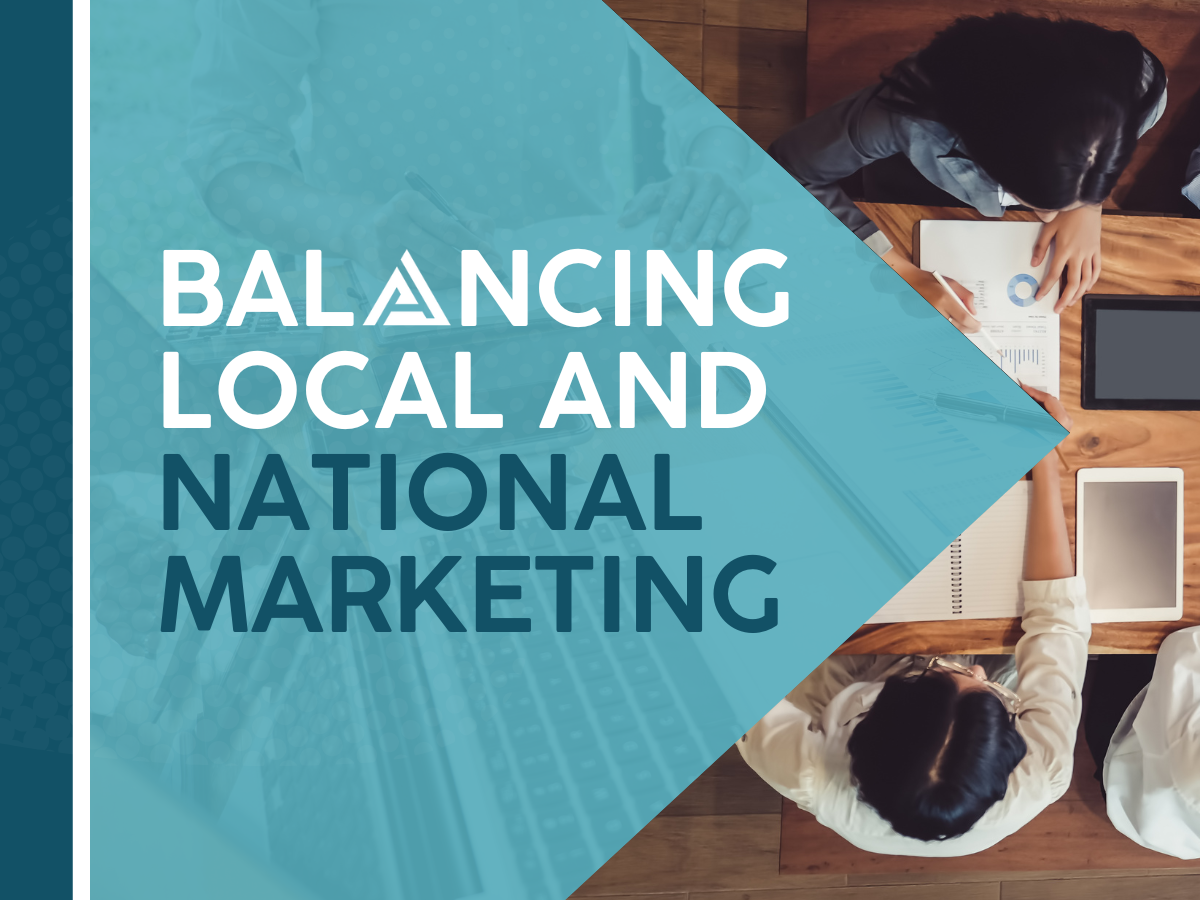Multi-location businesses are complex entities – no two locations are truly alike. Customer demographics, market demands, and even cultural preferences can – and usually do – differ dramatically from one location to another. Yes, a centralized marketing strategy gives you cohesion and structure, but it has to allow for localized adaptation. To keep on connecting with unique, local audiences, this is extremely important.
Simply put, a successful marketing strategy is one that successfully balances scale and specificity – two seemingly opposing forces.
In this article we’ll look at how multi-location businesses and private equity-back portfolios can create a solid unified marketing framework. That means it has to be one that supports consistency and flexibility at all levels of business. Get this right, and you’ll be much more successful at balancing your national brand identity with your likely many local campaigns.
The Balancing Act: Centralization vs. Localization
Marketing scales best when you can adapt a larger brand message to many different local markets. Sounds easy, right? Centralization should give you the control and efficiency, while localization is the tool you’ll use for catering to all of these different markets.
So how do businesses combine these approaches effectively?
Centralization: The Foundation for Brand Consistency
Centralization is the structure, the foundation, that multi-location businesses need to scale. It keeps branding, messaging, and customer experience in line across all of your locations and anywhere you have a presence.
Benefits of Centralization:
- Brand Integrity: Truly cohesive messaging and visuals go a long way to strengthen trust and recognition across different markets.
- Efficiency: Centralized tools and processes keep duplicate efforts at a minimum, and help to streamline operations.
- Data Insights: A unified and centralized approach makes performance tracking much easier. This lets you more intelligently allocate resources, and you get straightforward proof of ROI.
Examples of Centralized Strategies:
- Developing national campaigns that can serve as the backbone for local or regional adaptations.
- Creating branding guidelines, templates, and tools for all of your locations. Include imagery, written content, and video material.
- Using centralized marketing technologies like CRM systems or automation platforms.
Localization: Building Stronger Customer Connections
While centralization gets you the consistency in branding and messaging, localization drives home your relevance. Study after study shows that customers are far more likely to respond to messaging that reflects their community’s unique values and culture.
Benefits of Localization:
- Customer Relevance: Customized messaging is always more relatable to local audiences.
- Market Responsiveness: Local teams can adapt a lot more quickly to regional trends or changes in the competition.
- Community Trust: Supporting local events and causes builds goodwill in the community and strengthens local relationships.
Examples of Localized Strategies:
- Offering region-specific promos or seasonal local campaigns.
- Highlighting local testimonials, partnerships, and events in your local marketing materials.
- Attending local or regional events to remain visible and contribute to the local community.
- Adjusting your visuals and language to reflect different cultural preferences.
Strategic Framework for Balancing Scale and Specificity
To balance scale and specificity, a multi-location business has to create and stick to a structured but flexible framework. Here are the key elements in a strategy like this:
1. Define Core Brand Elements
Start by identifying the non-negotiable aspects of your brand – things that must remain consistent across all locations.
Core Elements to Standardize:
- Brand voice, tone, and your visual identity (logo, company imagery, etc.)
- Any key messaging that reflects your company’s mission and values (company mission, philosophy, about, etc.).
- High-level campaign themes or objectives.
By defining these elements first, you’re creating a foundation that all of your locations can build on. But you’ll still be able to maintain brand cohesion, with a set of guidelines in place for everyone.
2. Empower the Local Teams
For personalization, use your biggest strength: your local teams! Make sure you give them all of the resources they’ll need, and make sure you allow them the autonomy they need to be effective in their local campaigns.
How to Do This:
- Give them pre-approved marketing assets, like templates for ads, social media post templates, or flyers. Make sure you leave room for them to be customized.
- Make it required that they complete training on branding guidelines and local marketing best practices.
- Set up feedback loops so your local teams can share ideas and updates on progress with corporate or franchise teams.
Pro Tip: Create a centralized knowledge hub where local managers can access branding resources or campaign playbooks. The easier it is to find it and use it, the more often people will turn to it.
3. Leverage Data for Smarter Decision-Making
Data, then, would be the bridge between scale and specificity; it’ll let you keep a finger on the pulse of your marketing efforts. When you’ve got enough data to analyze your KPIs at the national and local levels, you can quickly identify what’s working and what’s not.
Key Data to Track:
- Engagement metrics (e.g., clicks, impressions, and conversions) for all local ad campaigns (Use UTMs, call tracking, and other geo-specific analytics for more granular data)
- Customer demographics and behavior patterns, all segmented by location or region.
- ROI comparisons across different locations to analyze and improve resource allocation.
Use tools like Google Analytics (GA4), and BrightLocal to gather and visualize local data in real time. This will let you fine-tune your strategies and make sure you’re getting the most impact out of your campaigns.
4. Test, Learn, and Iterate
No strategy is perfect from the start, despite our best efforts. With a test-and-learn mindset, you can refine your approach over time.
Steps to Iterate Successfully:
- Run pilot programs first in select locations, to test new ideas before you scale them nationally.
- A/B test as much of your localized messaging, visuals, or promotions as possible, to see what people are gravitating towards.
- Analyze the campaign results and use the insights to inform your future efforts. Key to successful iterations.
Real-World Example: A National Vein Clinic Network
Here’s an example of a successful balancing of scale and specificity: A national vein clinic network. This particular organization wanted to promote its varicose vein treatments, but they faced vastly different audience priorities in different regions across the US.
Centralized Approach:
Their corporate team came up with a national campaign with the overarching message: “Rediscover Confidence with Healthier Legs.” They gave their local teams pre-designed templates, ad copy, and images to use.
Localized Adaptations:
- In Miami, their vein clinics put a strong focus on cosmetic results, adjusting their message to really highlight “beach-ready legs” for their beach-body-conscious audience.
- In Denver, however, the messaging was focused on relieving pain and discomfort, and improving mobility – targeted the active outdoor lifestyles of the local residents in Colorado.
- And at the same time, social media campaigns in every region featured local patient testimonials, to build trust and credibility.
Results: With a centralized strategy and localized execution, the network saw a 20% increase in appointment bookings across all locations, with very significant growth in both Miami and Denver.
Key Takeaways: The Art of Balancing Scale and Specificity
- Centralize for Consistency: Standardize the branding, messaging, and technology to create a solid foundation for both employees and customers/potential customers.
- Localize for Relevance: Give local teams the power to adapt campaigns to their markets, so long as they stay aligned with the core brand guidelines.
- Leverage Data: Use performance metrics and insights to guide your decision-making, and continuously improve your approach.
- Stay Agile: Test new ideas, learn from the results, and refine your strategies to keep up with new market dynamics.
If you master this balance between scale and specificity, your multi-location businesses can take advantage of marketing strategies that not only work, but work so well that you won’t be able to wait to try them again. In the next article, we’ll cover one of the most powerful tools for driving local visibility: Local SEO. Learn how to optimize your local digital presence, and attract customers to drive ROI at every location.











